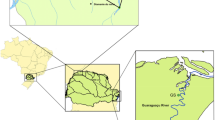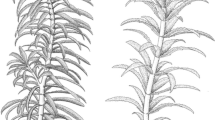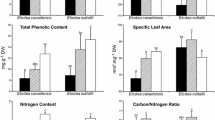Abstract
Salinity plays an important role in macrophyte distribution. The current increase in salinization of native freshwaters could modify their susceptibility to invasion. In this study, we determined the tolerance to salt of two invasive macrophytes: Elodea canadensis and Elodea nuttallii. We analysed their growth, regeneration and colonization abilities and the influence of their phenological stage in their response to salt in a laboratory experiment. Traits of both Elodea species varied according to the season and the salt concentration: they were more affected by salt in autumn than in spring, demonstrating higher salt tolerance in spring than in autumn. The two species were sensitive to different thresholds of salinity, although they were both strongly reduced at 3 g l−1 of salt in autumn. Consequently, salt marshes and brackish waters (salt concentration inferior to 3 g l−1 of salt) are likely to be invaded by both species, but the effect of salt levels superior to 3 g l−1 on plant invasiveness needs to be investigated.


Similar content being viewed by others
References
Abraham, G., 2010. Antioxidant enzyme status in Azolla microphylla in relation to salinity and possibilities of environmental monitoring. Thin Solid Films 519(3): 1240–1243.
Adamec, L., 2010. Tissue mineral nutrient content in turions of aquatic plants: does it represent a storage function? Fundamental and Applied Limnology/Archiv für Hydrobiologie 176(2): 145–151.
Barrat-Segretain, M. H., 1996. Strategies of reproduction, dispersion, and competition in river plants: a review. Plant Ecology 123(1): 13–37.
Barrat-Segretain, M. H. & G. Bornette, 2000. Regeneration and colonization abilities of aquatic plant fragments: effect of disturbance seasonality. Hydrobiologia 421: 31–39.
Barrat-Segretain, M. H., G. Bornette & A. Hering-Vilas-Boas, 1998. Comparative abilities of vegetative regeneration among aquatic plants growing in disturbed habitats. Aquatic Botany 60(3): 201–211.
Bertness, M. D., L. Gough & S. W. Shumway, 1992. Salt tolerances and the distribution of fugitive salt-marsh plants. Ecology 73(5): 1842–1851.
Blindow, I., J. Dietrich, N. Möllmann & H. Schubert, 2003. Growth, photosynthesis and fertility of Chara aspera under different light and salinity conditions. Aquatic Botany 76(3): 213–234.
Brock, M. A., D. L. Nielsen & K. Crossle, 2005. Changes in biotic communities developing from freshwater wetland sediments under experimental salinity and water regimes. Freshwater Biology 50(8): 1376–1390.
Cañedo-Argüelles, M., B. J. Kefford, C. Piscart, N. Prat, R. B. Schäfer & C.-J. Schulz, 2013. Salinisation of rivers: an urgent ecological issue. Environmental Pollution 173: 157–167.
Cañedo-Argüelles, M., C. Hawkins, B. Kefford, R. Schäfer, B. Dyack, S. Brucet, D. Buchwalter, J. Dunlop, O. Frör & J. Lazorchak, 2016. Saving freshwater from salts. Science 351(6276): 914–916.
Cheeseman, J. M., 1988. Mechanisms of salinity tolerance in plants. Plant Physiology 87(3): 547–550.
Chytry, M., V. Jarosik, P. Pysek, O. Hajek, I. Knollova, L. Tichy & J. Danihelka, 2008. Separating habitat invasibility by alien plants from the actual level of invasion. Ecology 89(6): 1541–1553.
Cook, C. D. K. & K. Urmi-König, 1985. A revision of the genus Elodea (Hydrocharitaceae). Aquatic Botany 21(2): 111–156.
Davis, M. A., J. P. Grime & K. Thompson, 2000. Fluctuating resources in plant communities: a general theory of invasibility. Journal of Ecology 88(3): 528–534.
de Oliveira, A. B., N. L. M. Alencar & E. Gomes-Filho, 2013. Comparison between the water and salt stress effects on plant growth and development. In Akinci, S. (ed.), Responses of Organisms to Water Stress. InTech, Rijeka.
Deegan, B., T. J. Harrington & P. Dundon, 2005. Effects of salinity and inundation regime on growth and distribution of Schoenoplectus triqueter. Aquatic Botany 81(3): 199–211.
Di Nino, F., G. Thiebaut & S. Muller, 2007. Phenology and phenotypic variation of genetically uniform populations of Elodea nuttallii (Planch.) H. St John at sites of different trophic states. Fundamental and Applied Limnology 168(4): 335–343.
Elton, C., 1958. The Ecology of Invasions by Animals and Plants. University of Chicago, Chicago.
French, G. T. & K. A. Moore, 2003. Interactive effects of light and salinity stress on the growth, reproduction, and photosynthetic capabilities of Vallisneria americana (wild celery). Estuaries 26(5): 1255–1268.
Goodman, A. M., G. G. Ganf, G. C. Dandy, H. R. Maier & M. S. Gibbs, 2010. The response of freshwater plants to salinity pulses. Aquatic Botany 93(2): 59–67.
Haller, W. T., D. L. Sutton & W. C. Barlowe, 1974. Effects of salinity on growth of several aquatic macrophytes. Ecology 55(4): 891–894.
Hart, B. T., P. Bailey, R. Edwards, K. Hortle, K. James, A. McMahon, C. Meredith & K. Swadling, 1991. A review of the salt sensitivity of the australian fresh-water biota. Hydrobiologia 210(1–2): 105–144.
Hauenstein, E. & C. Ramírez, 1986. The influence of salinity on the distribution of Egeria densa in the Valdivia river basin, Chile. Archiv für Hydrobiologie 107(4): 511–519.
Herault, B., A. Bornet & M. Tremolieres, 2008. Redundancy and niche differentiation among the European invasive Elodea species. Biological Invasions 10(7): 1099–1107.
Herbert, E. R., P. Boon, A. J. Burgin, S. C. Neubauer, R. B. Franklin, M. Ardón, K. N. Hopfensperger, L. P. Lamers & P. Gell, 2015. A global perspective on wetland salinization: ecological consequences of a growing threat to freshwater wetlands. Ecosphere 6(10): 1–43.
Hutchinson, G. E., 1975. A Treatise on Limnology, Vol. III. Limnological Botany. Wiley, New York: 660 pp.
James, K. R. & B. T. Hart, 1993. Effect of salinity on 4 freshwater macrophytes. Australian Journal of Marine and Freshwater Research 44(5): 769–777.
James, K. R., B. T. Hart, P. C. E. Bailey & D. W. Blinn, 2009. Impact of secondary salinisation on freshwater ecosystems: effect of experimentally increased salinity on an intermittent floodplain wetland. Marine and Freshwater Research 60(3): 246–258.
Jampeetong, A. & H. Brix, 2009. Effects of NaCl salinity on growth, morphology, photosynthesis and proline accumulation of Salvinia natans. Aquatic Botany 91(3): 181–186.
Lokhande, V. H., T. D. Nikam & S. Penna, 2010. Biochemical, physiological and growth changes in response to salinity in callus cultures of Sesuvium portulacastrum L. Plant Cell, Tissue and Organ Culture (PCTOC) 102(1): 17–25.
Lonsdale, W. M., 1999. Global patterns of plant invasions and the concept of invasibility. Ecology 80(5): 1522–1536.
May, M. J., T. Vernoux, C. Leaver, M. Van Montagu & D. Inzé, 1998. Glutathione homeostasis in plants: implications for environmental sensing and plant development. Journal of Experimental Botany 49(321): 649–667.
McGregor, E. B., K. R. Solomon & M. L. Hanson, 2007. Monensin is not toxic to aquatic macrophytes at environmentally relevant concentrations. Archives of Environmental Contamination and Toxicology 53(4): 541–551.
Munns, R., 2002. Comparative physiology of salt and water stress. Plant Cell and Environment 25(2): 239–250.
Munns, R. & M. Tester, 2008. Mechanisms of salinity tolerance. Annual Review of Plant Biology 59: 651–681.
Nielsen, D. L., M. A. Brock, G. N. Rees & D. S. Baldwin, 2003. Effects of increasing salinity on freshwater ecosystems in Australia. Australian Journal of Botany 51(6): 655–665.
Parida, A. K. & A. B. Das, 2005. Salt tolerance and salinity effects on plants: a review. Ecotoxicology and Environmental Safety 60(3): 324–349.
Petjukevičs, A., A. Batjuka & N. Škute, 2015. The impact of different levels of sodium chloride on the quantitative changes of chlorophyll and carotenoids in chloroplasts of Elodea canadensis (Michx. 1803). Biology 61(1): 34–41.
Piscart, C., J.-C. Moreteau & J.-N. Beisel, 2006. Fluctuating asymmetry of natural populations of aquatic insects along a salinity gradient. Environmental Bioindicators 1(4): 229–241.
Rout, N. P. & B. P. Shaw, 2001. Salt tolerance in aquatic macrophytes: possible involvement of the antioxidative enzymes. Plant Science 160(3): 415–423.
Seebens, H., T. Blackburn, E. Dyer, P. Genovesi, P. Hulme & J. Jeschke, 2016. No saturation in the accumulation of alien species worldwide. Nature Communications 8: 14435.
Sim, L. L., J. M. Chambers & J. A. Davis, 2006. Ecological regime shifts in salinised wetland systems. I. Salinity thresholds for the loss of submerged macrophytes. Hydrobiologia 573: 89–107.
Smith, M. J., K. M. Ough, M. P. Scroggie, E. S. G. Schreiber & M. Kohout, 2009. Assessing changes in macrophyte assemblages with salinity in non-riverine wetlands: a Bayesian approach. Aquatic Botany 90(2): 137–142.
Thiebaut, G., 2007a. Invasion success of non-indigenous aquatic and semi-aquatic plants in their native and introduced ranges. A comparison between their invasiveness in North America and in France. Biological Invasions 9(1): 1–12.
Thiébaut, G., 2007b. Non-indigenous aquatic and semiaquatic plant species in France. In Gherardi, F. (ed.), Biological Invaders in Inland Waters: Profiles, Distribution, and Threats Invading Nature., Springer Series in Invasion Ecology Springer, Dordrecht: 209–229.
Thiebaut, G. & S. Muller, 2003. Linking phosphorus pools of water, sediment and macrophytes in running waters. Annales de Limnologie – International Journal of Limnology 39(04): 307–316.
Thiébaut, G., S. Muller & M. Tremolières, 2008. Etude comparative de deux espèces végétales aquatiques invasives en France: Elodea nuttallii et E. canadensis. Stratégies adaptatives, facteurs écologiques, polymorphisme génétique des espèces. Contribution au contrôle du phénomène invasif.
Thouvenot, L., C. Deleu, S. Berardocco, J. Haury & G. Thiébaut, 2015. Characterization of the salt stress vulnerability of three invasive freshwater plant species using a metabolic profiling approach. Journal of Plant Physiology 175: 113–121.
Tripathi, S. B., K. Gurumurthi, A. K. Panigrahi & B. P. Shaw, 2007. Salinity induced changes in proline and betaine contents and synthesis in two aquatic macrophytes differing in salt tolerance. Biologia Plantarum 51(1): 110–115.
Twilley, R. R. & J. W. Barko, 1990. The growth of submersed macrophytes under experimental salinity and light conditions. Estuaries 13(3): 311–321.
van den Brink, F. W. B. & G. van der Velde, 1993. Growth and morphology of four freshwater macrophytes under the impact of the raised salinity level of the Lower Rhine. Aquatic Botany 45(4): 285–297.
Vila, M. & E. Garcia-Berthou, 2010. Monitoring biological invasions in freshwater habitats. In Hurford, C., M. Schneider & I. G. Cowx (eds) Conservation Monitoring in Freshwater Habitats: A Practical Guide and Case Studies. Springer, Dordrecht: 91–100.
Warwick, N. W. M. & P. C. E. Bailey, 1997. The effect of increasing salinity on the growth and ion content of three non-halophytic wetland macrophytes. Aquatic Botany 58(1): 73–88.
Warwick, N. W. M. & P. C. E. Bailey, 1998. The effect of time of exposure to NaCl on leaf demography and growth for two non-halophytic wetland macrophytes, Potamogeton tricarinatus F. Muell. and A. Benn. Ex A. Benn. and Triglochin procera R Br. Aquatic Botany 62(1): 19–31.
Xie, D., D. Yu, C. Xia & W. You, 2014. Stay dormant or escape sprouting? Turion buoyancy and sprouting abilities of the submerged macrophyte Potamogeton crispus L. Hydrobiologia 726(1): 43–51.
Zedler, J. B., E. Paling & A. McComb, 1990. Differential responses to salinity help explain the replacement of native Juncus kraussii by Typha orientalis in western-australian salt marshes. Australian Journal of Ecology 15(1): 57–72.
Zehnsdorf, A., A. Hussner, F. Eismann, H. Rönicke & A. Melzer, 2015. Management options of invasive Elodea nuttallii and Elodea canadensis. Limnologica – Ecology and Management of Inland Waters 51: 110–117.
Zimmermann-Timm, H., 2007. Salinisation of inland waters. In Lozan, J., H. Grssl, P. Hupfer, L. Menzel & C. Schönwiese (eds), Water Uses and Human Impacts on the Water Budget. Verlag Wissenschaftliche Auswertungen/GEO, Hamburg: 133–136.
Acknowledgements
We thank Philippe Rousselle for performing the water analysis and Philippe Wagner for field assistance.
Author information
Authors and Affiliations
Corresponding author
Additional information
Guest editors: John E. Havel, Sidinei M. Thomaz, Lee B. Kats, Katya E. Kovalenko & Luciano N. Santos / Aquatic Invasive Species II
Rights and permissions
About this article
Cite this article
Thouvenot, L., Thiébaut, G. Regeneration and colonization abilities of the invasive species Elodea canadensis and Elodea nuttallii under a salt gradient: implications for freshwater invasibility. Hydrobiologia 817, 193–203 (2018). https://doi.org/10.1007/s10750-018-3576-1
Received:
Revised:
Accepted:
Published:
Issue Date:
DOI: https://doi.org/10.1007/s10750-018-3576-1




